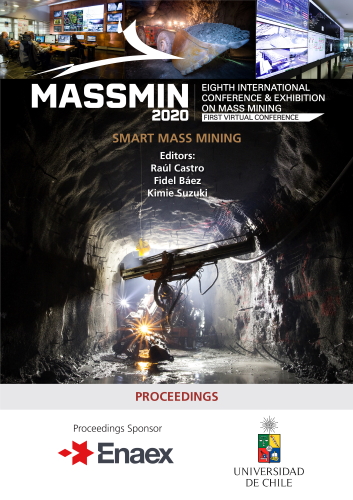Development of a discrete event simulation model for cave mining ore handling systems with open source tools

|
Authors: Silva, DA |
This paper is hosted with the kind permission of Lulea University of Technology, International Conference & Exhibition on Mass Mining, 2024.
DOI https://doi.org/10.36487/ACG_repo/2063_42
Cite As:
Silva, DA 2020, 'Development of a discrete event simulation model for cave mining ore handling systems with open source tools', in R Castro, F Báez & K Suzuki (eds), MassMin 2020: Proceedings of the Eighth International Conference & Exhibition on Mass Mining, University of Chile, Santiago, pp. 633-645, https://doi.org/10.36487/ACG_repo/2063_42
Abstract:
The ore handling systems represent one of the largest expenses in cave mining, while the productivity and cost of a given production system can significantly impact the value of mining projects and operations. Moreover, in recent years the increase in mineral production using mass mining methods has led to significant progress in extraction techniques as well as equipment and technologies. Simulations are used to mimic real situations of production systems to aid in the design of new concepts and make engineered decisions. Discrete event simulation (DES) techniques can be applied to a wide range of analyses in cave mining, from refinement of cost and feasibility of plans or schedules to understanding the system behaviour for better decisions before expenses. This paper discusses the foundations to build a simulation model, while presenting the development of a discrete event simulation code using the R-Simmer package for the R language, to estimate productivity and capacity of an underground mining production system. Models using open source tools are intended to be an alternative to commercial simulation software, which can be onerous and restricted to specific settings. The outcome of this work constitutes a novel contribution to the simulation field, with the benefit to help design and assess cave mining ore handling systems but also create the basis of a future fully open-source simulation tool for cave mining.
References:
Banks, J, Carson, JS & Nelson, BL 1996, ´Discrete-Event System Simulation, 2nd Ed.́ , Published by Prentice-Hall International, London.
Barraza, M, Rohrer, M & Hustrulid, W 2004, ´Application of simulation to improved planning at Esmeralda, El Teniente Mine, Chile, Proceedings of MassMin 2004, Santiago, Chile.
Botha, J, Watson, S, Arkadius, T, Samosir, T 2008, ´Simulation Applications at PT Freeport Indonesia’s DOZ/ESZ Block Cave Mine ,́ in H Schunnesson, E Nordlund (eds), Proceedings of MassMin 2008, Lulea, Sweden.
Brunner, D 2001, ´Simulation of Underground Mining Operations ,́ Underground Mining Methods, ed. SME 2001, Denver.
Byrne, J, Heavey, C, Byrne, PJ 2010, ´A review of Web-based simulation and supporting tools ,́ Simulation modelling practice and theory, Vol. 18, Issue 3.
Codelco 2014, ´Teniente 7 Stage 1 Simulation Report at El Teniente Mine ,́ Codelco Internal Report, Chile (Unpublished).
Dagkakis, G, Heavey, C 2016, ´A review of open-source discrete event simulation software for operations research ,́ Journal of Simulation, London.
Harrel, C, Bowden, R & Ghosh, BK 2011, ´Simulation using Promodel ,́ McGraw-Hill, Boston.
Pretorius, D & Nigidi, S 2008, ´Cave management ensuring optimal life of mine at Palabora ,́ in H Schunnesson, E Nordlund (eds), Proceedings of MassMin 2008, Lulea, Sweden.
Puhakka, T & Kainulainen, V 2000, ´Use of OPTIMINE™ Simulation Tool for Mobile Fleet Selection ,́ in G Chitombo (ed.), Proceedings of MassMin 2000, Australian Institute of Mining and Metallurgy, Melbourne, Australia.
RPM 2015, ´Personal communication ,́ Runge Pincock Minarco, Brisbane. [Unpublished].
Silva, D 2017, ́An Integrated Methodology for the Design and Assessment of Cave Mining Ore Handling Systems ,́ MPhil Thesis, Sustainable Minerals Institute, The University of Queensland, Brisbane.
© Copyright 2025, Australian Centre for Geomechanics (ACG), The University of Western Australia. All rights reserved.
View copyright/legal information
Please direct any queries or error reports to repository-acg@uwa.edu.au
View copyright/legal information
Please direct any queries or error reports to repository-acg@uwa.edu.au
